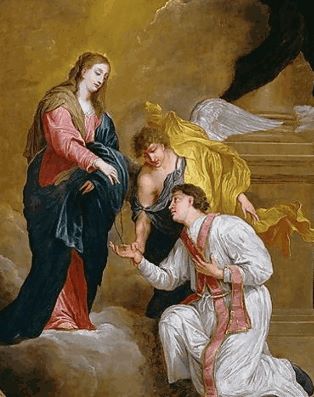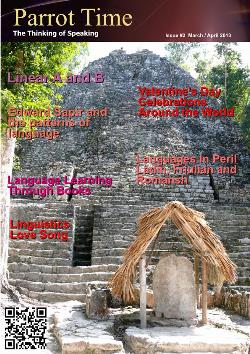
|
Love! Most people around the world know that the day of love and lovers is Saint Valentine's Day, on February 14th. On this day, people express their love for special people in their lives in various ways. But who was this Saint Valentine, and why is he so linked to love? It is common for the Christian church to set aside days to celebrate specific saints for their actions. In this case, there were at least three saints named Valentine, all martyrs (people who have died for a particular cause) and all dying on February 14th. The first was Valentine of Rome who was a priest in Rome, killed around 269 AD, and buried on the Via Flaminia. His flower crowned skull is on exhibit in the Basilica of Santa Maria in Cosmedin, Rome. The second was Valentine of Terni who became a bishop then a martyr during the rule of Emperor Aurelian. He was also buried on the Via Flaminia but in a different location, and his relics are at the the Basilica of Saint Valentine in Terni. The third Valentine was martyred in Africa, but little else is known of him. ...it had become a common practice in England to give gifts and exchange handmade cards on Valentine's Day. In the official church biographies of these saints, there are no romantic attachments, and by the time anything involving romance was linked to Saint Valentine in the fourteenth century, any distinction between which Valentine was involved was lost. Saint Valentine's head was preserved and respected in the abbey of New Minster in Winchester, England, but no celebrations for him differed from any other celebration of other saints. Legends  Painting of St. Valentine kneeling by David Teniers III Historical research has most scholars believing that Saint Valentine was a priest near Rome around 270 AD, a time when the church was under persecution by the Roman Emperor Claudius II. Many priests worked to help Christians escape persecution as well as provide them with basic sacraments (a sacred rite recognized as of particular importance and significance) such as marriage, which was outlawed during this time. More information than that, however, becomes mixed with myth and legends. In the 6th century, a story by Passio Marii et Marthae was published telling of the martyrdom of a Saint Valentine of Rome. It states that Valentine was caught and interrogated by Emperor Claudius II personally. Claudius is said to have been impressed by Valentine and tried to convert him to Roman paganism in exchange for his life. Valentine refused, however, and instead tried to convert the emperor to Christianity. For this impunity, we was sentenced to be executed. While awaiting his execution, he supposedly performed a miracle by curing the blind daughter of his jailer. When he did this, the jailer, his daughter, and forty-six other people came to believe in Jesus and were baptized. Another part of the legend is that on the night of his execution, Valentine sent the daughter a letter and signed it "from your Valentine". A further legend is that while having illegal weddings for other Christians, Valentine reportedly cut small hearts out of parchment and gave them to the persecuted Christians as a reminder of God's love. Lupercalia There was an archaic pagan rite associated with fertility and love called Lupercalia which was celebrated on February 13-15 until it was abolished by Pope Gelasius around 492 AD. Although there is no historical facts connecting this with Saint Valentine's day, many people do believe they are related. Chaucer  So when and why did Saint Valentine become associated with love? The first recorded connection came from a poem by Geoffrey Chaucer in 1382 named "Parlement of Foules". The primary verse which addresses this was: For this was on seynt Volantynys day For those whose Old English is a bit rusty, it translates to "For this was on Saint Valentine's Day, when every bird cometh there to choose his mate.".  Man and woman with Valentine’s Day gifts The poem was in honor of the first anniversary of the engagement of King Richard II of England to Anne of Bohemia. The reference to Saint Valentine's day connects this celebration of love along with that of couples finding their mates. However, some scholars have pointed out that February is too early a time for birds to be mating and that the day in question might be referring instead to May 2nd, which is the celebration of Valentine of Genoa who was a bishop that died around 307 AD. Regardless, the connection along with the previously mentioned legends and the date of Lupercalia have all helped to solidify Saint Valentine's Day of February as a time for lovers and loved ones. French and English literature of the fourteenth century talks about the practice of lovers using this day to exchange special love letters and tokens. In the following centuries the holiday evolved and by the 18th century, it had become a common practice in England to give gifts and exchange hand-made cards on Valentine's Day. This eventually spread to the American colonies, then to other countries. |
| Celebrations - Valentine's Day | ||||||||||||||
| Writer: | Sonja Krüger | |||||||||||||
| Images: | ||||||||||||||
| ||||||||||||||
| Sources: | ||||||||||||||
| ||||||||||||||
All images are Copyright - CC BY-SA (Creative Commons Share Alike) by their respective owners, except for Petey, which is Public Domain (PD) or unless otherwise noted.
comments powered by Disqus



















